Improve Shopify Conversion Rate: 10 Winning Strategies
May 6, 2025
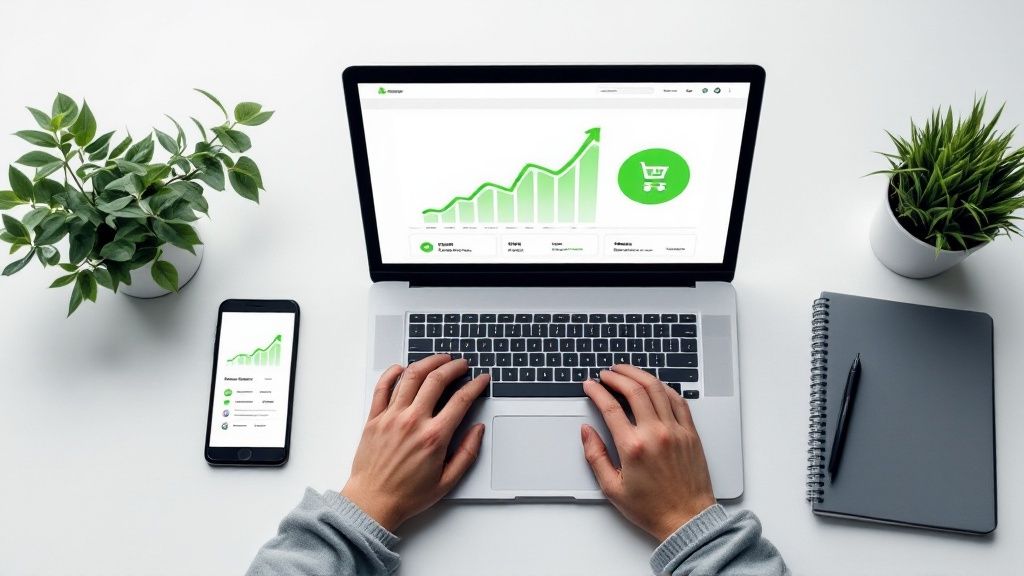
Understanding What Actually Drives Shopify Conversion Success
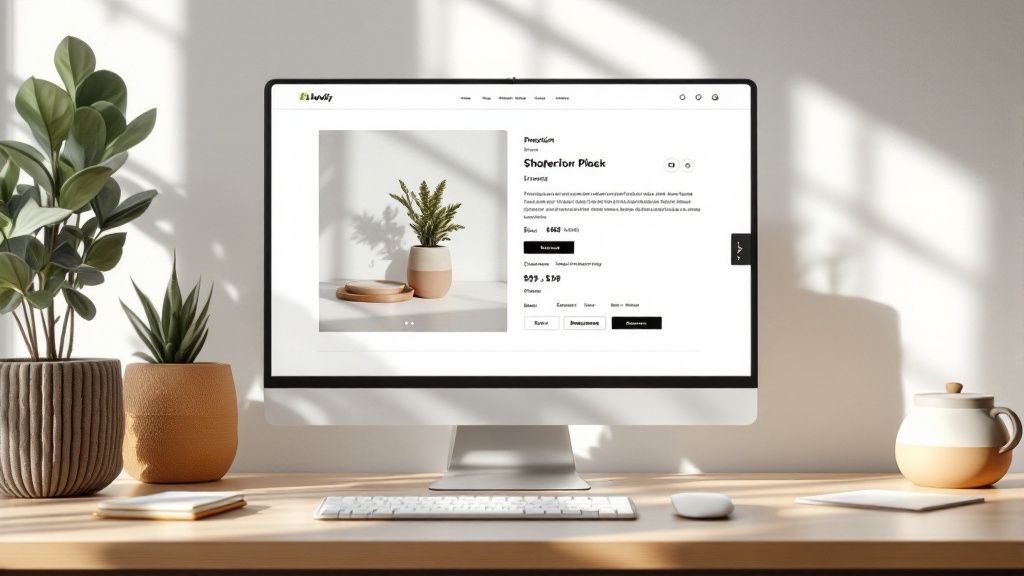
Before diving into specific tactics to improve your Shopify conversion rate, it's essential to understand the core principles driving success. Simply copying others without understanding why their strategies work can lead to wasted time and disappointing results. This section explores the fundamental elements that power conversions, building a solid base for your optimization strategy.
Beyond the Average: Benchmarking Your Shopify Store
While you might encounter average Shopify conversion rates, focusing solely on these numbers can be misleading. Conversion benchmarks vary significantly across industries. For example, a store selling luxury watches will likely have a lower conversion rate than one selling everyday household goods. Seasonal fluctuations also play a role, with spikes during holiday seasons and dips during slower periods. Understanding your specific industry and seasonality is key.
Furthermore, prioritizing high conversion rates without considering profitability can be harmful. A store might achieve high conversions with deep discounts, but if profit margins are too thin, the business model isn't sustainable. Focusing on revenue per visitor and customer lifetime value is just as crucial as the conversion rate itself. As of 2024-2025, the average Shopify conversion rate is 1.4%, with top performers reaching 4.7%—surpassing competitors by up to 36%.
This significant difference highlights the impact of strategic optimization. Stores implementing AI-powered product recommendations, like those offered by Recombee, see conversion increases of 5-15%. One-click checkout options, such as those from Bolt, reduce cart abandonment by up to 20%. Technical improvements also matter: page load speeds under two seconds yield 15-20% higher conversions. Mobile-first designs are critical, accounting for 50-70% of traffic in key markets like the US and EU. Without responsive layouts, mobile conversion rates lag behind desktop by 30%. Find more detailed statistics here. For a deeper dive into Shopify conversion rate optimization, check out this resource: How to master Shopify conversion rate optimization.
Measuring What Matters: Micro-Conversions and Cohort Analysis
High-performing Shopify stores go beyond overall conversion rates by analyzing micro-conversions. These are smaller actions indicating user engagement and progress towards a purchase, such as adding an item to a wishlist, subscribing to a newsletter, or starting a live chat. Tracking micro-conversions offers valuable insights into user behavior and helps pinpoint friction points in the customer journey.
Cohort analysis is another valuable tool. It involves grouping customers based on shared traits (e.g., acquisition date or first purchase value) and tracking their behavior over time. This helps understand how different customer segments interact with your store and identify segment-specific improvement areas. You might find, for example, that customers from social media have a lower average order value than those from email marketing, suggesting a need to optimize social media campaigns for higher-value purchases.
Setting Realistic Goals and Prioritizing Improvements
By understanding industry benchmarks, leveraging micro-conversions and cohort analysis, and focusing on metrics like revenue per visitor, you can set realistic goals. This data-driven approach helps prioritize improvements with the biggest impact on your bottom line. Instead of randomly implementing tactics, you can address specific bottlenecks and optimize for the most valuable customer segments. This targeted strategy sets the stage for sustainable conversion growth and long-term success.
Speed Optimization: The Conversion Catalyst Most Stores Miss
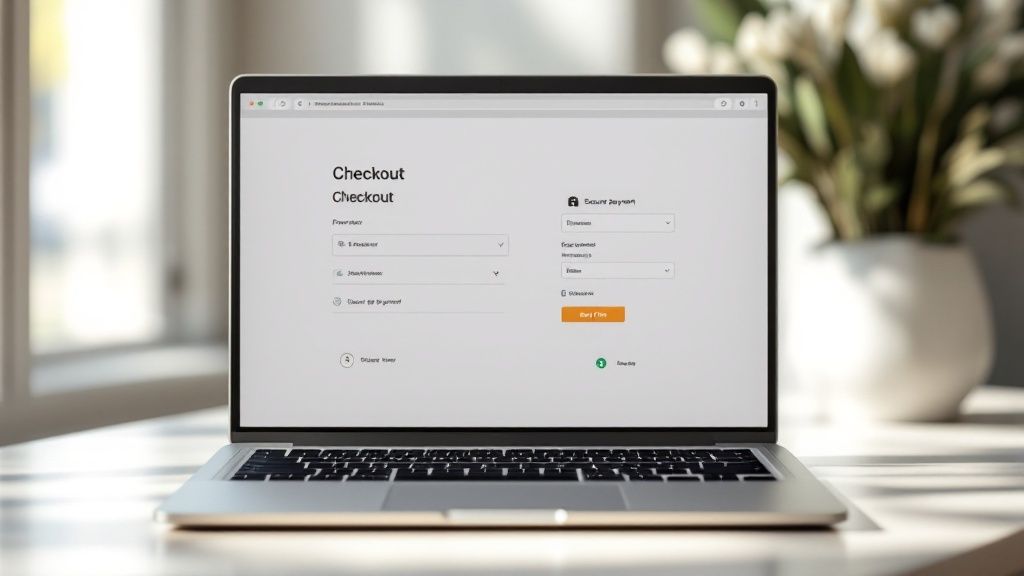
Understanding the drivers of conversion success and establishing realistic goals are essential for any online business. However, these efforts are futile if your Shopify store loads slowly. Site speed is fundamentally connected to your conversion rate. A slow website can significantly impact your ability to improve your Shopify conversion rate.
Milliseconds Matter: The Impact of Site Speed on Conversions
Research consistently reveals a strong link between site speed and conversion rates. For example, websites loading in one second boast a conversion rate 2.5 times higher than those taking five seconds to load. This isn't just a coincidence; data consistently shows that even minor speed improvements can lead to significant gains. Page speed is also a key factor in Google's ranking algorithm. A faster site improves your search visibility, driving more organic traffic.
Beyond PageSpeed Insights: Diagnosing and Prioritizing Speed Issues
While PageSpeed Insights offers a useful starting point for speed analysis, it doesn't provide a complete picture. Focusing solely on these scores can lead to optimizing for metrics that don't necessarily reflect the actual customer experience. GTmetrix offers more detailed performance insights, highlighting specific areas for improvement. Analyzing user behavior data through heatmaps and session recordings can also reveal how speed affects real customer interactions. This allows you to prioritize fixes based on their genuine impact on conversions.
Practical Techniques for Shopify Speed Optimization
You can take several actionable steps to significantly enhance your Shopify store's speed and, as a result, your conversion rate. These strategies have proven successful for numerous established stores. Optimizing images, for instance, by compressing them without compromising quality can significantly reduce load times. You can use tools like TinyPNG to achieve this.
-
Image Optimization: Compress images, utilize modern file formats like WebP, and implement lazy loading to defer image loading until necessary.
-
JavaScript Management: Minimize and combine JavaScript files to reduce HTTP requests and improve rendering time.
-
Third-Party App Evaluation: Carefully assess the performance impact of third-party apps, as they can considerably slow down your store.
-
Shopify-Specific Caching Strategies: Utilize Shopify's built-in caching mechanisms and consider using Content Delivery Networks (CDNs) to deliver content more quickly to users worldwide.
This optimization roadmap provides practical steps for making substantial improvements to your site speed. However, this is not a one-time solution. Continuous monitoring and optimization are crucial for sustained conversion growth. By addressing these core elements, you can transform your Shopify store from a slow, frustrating experience to a high-converting platform.
Crafting Mobile Experiences That Actually Convert
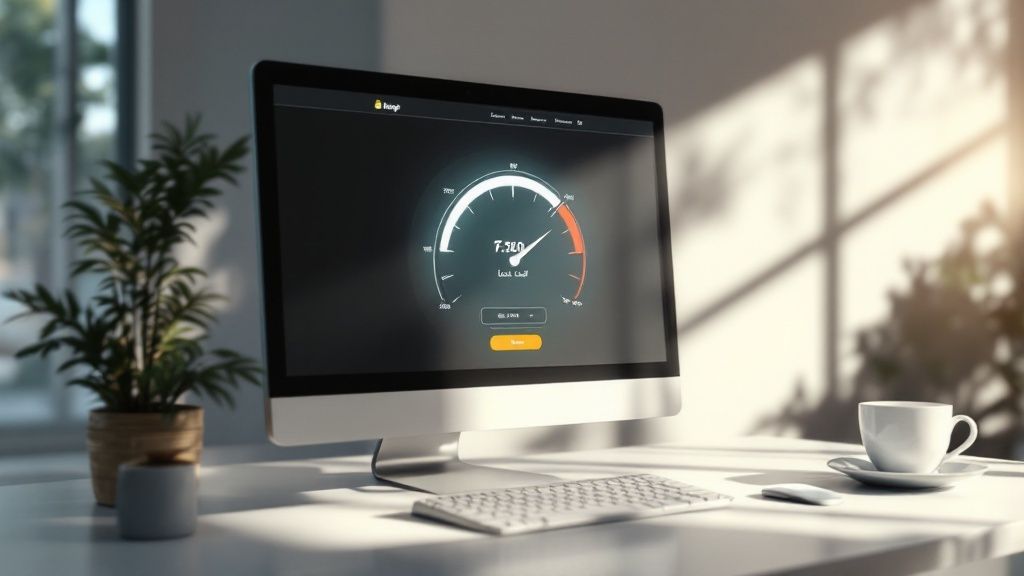
While optimizing site speed is crucial for improving your Shopify conversion rate, it's only one piece of the puzzle. A truly successful Shopify store understands that mobile users behave differently than desktop users and need a specifically designed experience. This goes beyond simply having a responsive design. It requires understanding how mobile users interact with your site and optimizing accordingly.
Why Responsive Design Isn't Enough
Responsive design ensures your website adapts to various screen sizes, but this doesn't guarantee a smooth mobile experience. A responsive site might shrink a desktop menu to fit a mobile screen, but if that menu remains cluttered and difficult to navigate with a thumb, it's not optimized for mobile users. Many stores miss this critical point, overlooking the unique challenges mobile users encounter.
For example, imagine a customer trying to add a product to their cart on a mobile device. They might struggle if the "Add to Cart" button is too small or poorly positioned for one-handed use. This seemingly small issue can lead to lost conversions, especially given the limited patience of mobile shoppers. Addressing these nuances is what separates high-performing mobile stores from the rest. This brings us to the important concept of thumb-zone mapping.
Thumb-Zone Mapping: Optimizing for One-Handed Use
Most mobile users operate their phones with one hand, primarily using their thumb for navigation. Thumb-zone mapping is the practice of designing your mobile interface with this in mind. Key elements like navigation menus, add-to-cart buttons, and checkout options should be easily reachable within the thumb's natural range of motion. This simple principle can significantly impact your add-to-cart rates and overall mobile conversions.
Simplifying Mobile Checkouts
Mobile checkout optimization is paramount. A complex checkout process contributes significantly to cart abandonment on any device, but it's particularly damaging on mobile where user patience is limited. Streamlining the mobile checkout is essential to improve your Shopify conversion rate. Consider offering express checkout options like Shop Pay, Apple Pay, or Google Pay to minimize the number of fields users need to complete manually.
Clearly displaying trust badges and security information can also reassure customers about their transaction's safety, reducing friction further. Industry benchmarks provide valuable insights. For example, Health & Wellness stores often see conversion rates around 4%, while Electronics stores may lag at 1.5%.
However, recent data highlights the importance of localized optimization. EU stores using GDPR-compliant pop-ups with clear value propositions (like "Get 10% off for newsletter sign-ups") see 2-3x higher opt-ins. APAC stores integrating local payment gateways (such as GrabPay or Alipay) experience 15-20% increases in conversions. Explore this topic further. Even using short video demos (under 90 seconds) on product pages can increase session durations by 20-30% and add-to-cart rates by 10-15%, showing that engaging content can be more effective than discounts in driving conversions.
Mobile-Specific Testing: Uncovering Hidden Friction Points
While best practices are a good starting point, true mobile optimization requires testing. Conduct A/B testing on different mobile layouts, button placements, and checkout flows to identify what works best for your target audience. Tools like heatmaps and session recordings can reveal where mobile users struggle, pinpointing areas for improvement.
Analyzing this data can uncover unexpected friction points and guide your optimization strategies toward the most impactful changes. By continuously refining the mobile experience through testing and data analysis, you can dramatically improve your Shopify conversion rate and unlock substantial growth potential.
Building a Data-Driven Conversion Optimization System
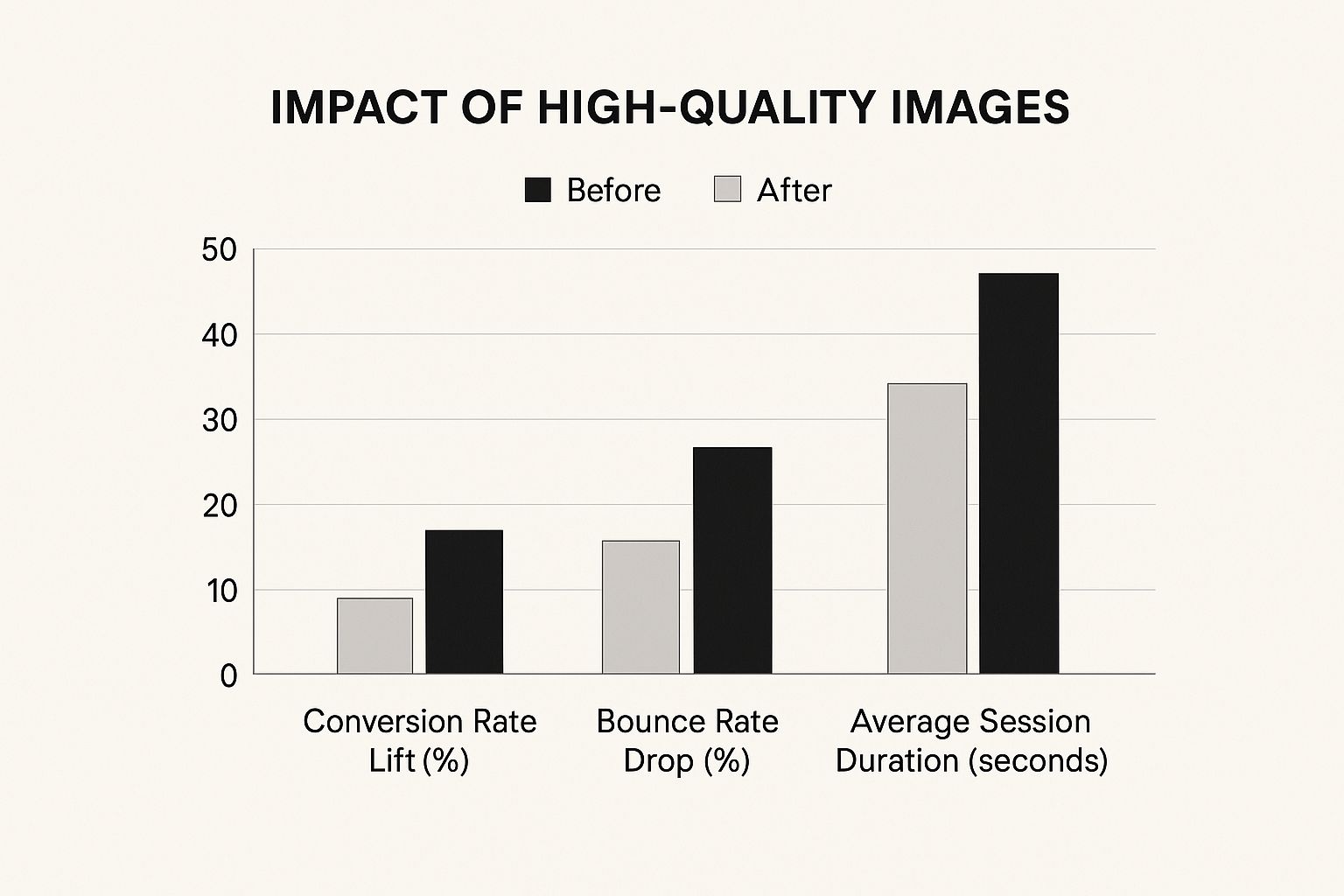
This data chart visualizes the impact of different optimization tactics on conversion rates. Building a robust system for Conversion Rate Optimization (CRO) is essential for sustained success on Shopify. Simply throwing random tactics at the wall won't yield the desired results. This section explores how successful Shopify stores use data to create effective optimization strategies, resulting in consistently higher conversion rates. You might find this resource helpful: How to master ecommerce conversion optimization. The chart highlights key areas where optimization efforts can have the biggest impact.
Prioritizing Optimization Opportunities With Behavioral Data
Successful Shopify merchants don't rely on guesswork. They use behavioral data to pinpoint areas for improvement, rather than basing decisions on opinions. Tools like heatmaps and session recordings offer invaluable insights into how customers interact with their online stores. This data reveals friction points in the customer journey, what elements capture customer attention, and where customers abandon their purchases.
By analyzing this information, you can prioritize the changes that will have the most significant impact on your Shopify conversion rate. For example, if heatmaps reveal that customers aren't clicking your call-to-action buttons, this signals a need for optimization. Perhaps the buttons aren't visually prominent enough, or the call-to-action text isn't compelling. Behavioral data eliminates the guesswork, ensuring you focus your resources effectively.
Hypothesis Testing and Customer Insights
Leading Shopify stores understand the importance of hypothesis testing. Instead of blindly following best practices, they develop specific hypotheses about what will improve their conversion rate. These hypotheses are then rigorously tested using A/B testing, comparing two versions of a page element to determine which performs better.
These hypotheses are not arbitrary; they're based on concrete customer insights gathered from behavioral data, customer surveys, and other sources. This approach ensures the tests are relevant and likely to drive meaningful improvements, while also reducing the risk of drawing incorrect conclusions.
Interpreting Results and Avoiding Statistical Pitfalls
Correctly interpreting A/B testing results is paramount for successful conversion optimization. Simply declaring a "winner" based on a small difference in conversion rates can be misleading. Understanding statistical significance ensures your results are reliable and not due to random chance. This involves considering the sample size of your test and the desired confidence level.
Let's take a look at how various optimization strategies have performed for a selection of Shopify stores. The following table presents data on the average conversion lift, implementation difficulty, and typical testing duration for common A/B testing elements.
A/B Testing Impact on Shopify Conversion Elements
| Page Element | Average Conversion Lift | Implementation Difficulty | Testing Duration |
|---|---|---|---|
| Call to Action Button Color | 5-15% | Easy | 1-2 weeks |
| Headline Text | 5-20% | Medium | 2-3 weeks |
| Product Image Placement | 2-8% | Easy | 1-2 weeks |
| Checkout Flow Simplification | 3-10% | Hard | 3-4 weeks |
| Product Description Length | 1-5% | Medium | 2-3 weeks |
This table provides a valuable overview of the potential impact of different optimization efforts. As you can see, even seemingly small changes can contribute to a notable lift in conversions. While checkout flow simplification might offer the biggest potential gains, it also requires more effort to implement. Consider these factors when prioritizing your testing roadmap.
Real-World Examples and Implementation Templates
The impact of systematic optimization is evident in numerous case studies. Many Shopify stores have seen remarkable improvements in their conversion rates through data-driven optimization programs. In 2025, the top 10% of Shopify stores are breaking the 4.7% conversion barrier by leveraging behavioral data. Heatmaps and session recordings often reveal 10-25% improvement opportunities in navigation flows. Adding trust signals like payment badges and live chat support can produce a 5-12% increase in conversions.
A/B testing remains essential. Changes to call-to-action button colors can yield a 5-15% variance in conversions, while urgency timers (like "3 left in stock") can drive immediate purchase spikes of 8-12%. Furthermore, stores using post-purchase upsells are increasing average order value by 10-30%, further compounding conversion gains. Learn more about impactful conversion rate tactics. By implementing a data-driven system, you can continuously improve your Shopify conversion rate and achieve sustainable growth.
Transforming Product Pages Into Decision Engines
Product pages are the heart of e-commerce, the place where browsing transforms into buying. They are the critical point in the customer journey where interest solidifies into a purchase decision. This section explores how to optimize your Shopify product pages to become powerful conversion engines, driving sales and boosting your bottom line.
Addressing Both Rational and Emotional Decision Factors
Effective product pages speak to both the rational and emotional drivers behind customer purchases. The rational side seeks concrete information: product specifications, pricing, and shipping details. The emotional side, however, connects with the story, the lifestyle, and the feeling of owning the product.
Successful Shopify merchants understand this duality. They offer comprehensive product details while also weaving a compelling narrative that resonates with their audience. This might involve showcasing lifestyle imagery, incorporating user-generated content, or highlighting the unique benefits of the product.
Sequencing Elements to Guide Visitors Toward Purchase
The presentation order of information on your product page significantly impacts the customer journey. A disorganized page can overwhelm visitors and hinder conversions. Think of it like a brick-and-mortar store – a cluttered layout makes it hard to find what you're looking for.
High-converting product pages follow a logical flow. They begin with the most essential information: high-quality product images, a clear product title, and a concise value proposition. As visitors scroll, they encounter more in-depth details, such as specifications, customer reviews, and shipping information. This strategic sequencing guides them smoothly towards the purchase.
Image Quality vs. Quantity: A Counterintuitive Approach
While multiple product images can be helpful, quality trumps quantity. A few stunning, high-resolution images showcasing different angles are more effective than numerous blurry, low-quality ones.
Consider enriching the visual experience with interactive elements like 360-degree views or zoom functionality. These features allow customers to examine the product closely, bridging the gap between online and in-store shopping and building confidence in their purchase decision.
The Power of Video (and When It Can Backfire)
Product videos are excellent for showcasing features, demonstrating functionality, and forging emotional connections. However, poorly executed videos can be detrimental. Overly long or low-quality videos can bore viewers and damage your brand image.
Keep videos short, concise, and focused on key selling points. Address common customer questions or demonstrate how the product solves a specific problem. A well-crafted video can significantly improve conversion rates.
Leveraging Social Proof to Build Trust and Drive Sales
Social proof plays a vital role in building trust and influencing buying decisions. Customer reviews, testimonials, and social media endorsements can all contribute to persuading potential customers.
The presentation of this social proof matters. Instead of a wall of text, opt for visually appealing testimonials featuring real customers and their experiences. Reviews accompanied by photos or videos can have a particularly strong impact.
Auditing and Optimizing Your Product Pages
Regularly auditing your product pages against conversion benchmarks is essential for continuous improvement. Analyze key metrics, identify areas for enhancement, and implement changes strategically. Tools like heatmaps and session recordings offer insights into how customers interact with your pages, revealing potential pain points and opportunities for optimization. Even small adjustments can significantly impact your bottom line.
Eliminating Checkout Friction That Kills Conversions
Cart abandonment is a major challenge for Shopify stores. It represents a significant loss of potential revenue. This section explores common friction points in the checkout process that lead to abandonment and offers effective solutions. We'll go beyond the basics and look at strategies used by truly high-converting stores.
Understanding the Psychology of Cart Commitment
The checkout process is more than just a series of technical steps. It's a psychological journey for the customer. Unexpected costs, complicated forms, and a lack of trust can create hesitation. Think of it like making a big purchase in person. You'd want clear pricing, a smooth transaction, and reassurance that your purchase is secure.
High-converting stores understand this. They prioritize building trust and minimizing psychological barriers. This might involve transparent pricing, visible security badges, and clear, concise language throughout checkout. These elements build customer confidence and encourage purchase completion.
Payment Presentation and Completion Rates
How you present payment options significantly impacts your Shopify conversion rate. Offering diverse payment methods caters to varying customer preferences. Displaying trusted payment gateways like PayPal, Apple Pay, and Shop Pay can boost conversions due to their familiarity and convenience.
Also, consider the placement and visual prominence of payment information. Clearly highlighting payment options and security details reassures customers. A customer worried about payment security is more likely to abandon their cart.
Beyond Basic Cart Emails: Advanced Recovery Strategies
Cart abandonment emails are a standard recovery tactic, but high-converting stores take it further. They personalize emails based on abandoned items and offer tailored incentives like free shipping or discounts. This targeted approach makes emails more relevant and effective.
For example, a customer abandons a cart with high-value items. A generic email might not be enough. But a personalized email with a small discount on those specific items could make the difference. This strategy targets high-potential lost revenue.
Optimizing Mobile Checkout for Higher Conversions
Mobile checkout optimization is critical. Mobile commerce is a significant and growing part of online sales. Mobile users often have less patience and are more sensitive to friction. Streamlining the mobile checkout process can significantly improve your Shopify conversion rate.
This might involve express checkout options, minimizing form fields, and optimizing the design for one-handed use. Consider thumb-zone placement to ensure key buttons are easily accessible.
Shopify Checkout vs. Custom Solutions: Choosing the Right Approach
Both Shopify Checkout and custom checkout solutions have pros and cons. Shopify Checkout offers a robust, secure platform with features like Shop Pay. Custom solutions offer greater flexibility and control.
The best approach depends on your specific needs and resources. If you need extensive customization or complex integrations, a custom solution might be better. However, Shopify Checkout offers a user-friendly, high-converting platform with minimal setup for most stores.
By considering these elements, from cart commitment psychology to mobile optimization, you can create a frictionless checkout experience. This will drive higher conversions and maximize your Shopify store's revenue. A smooth, intuitive, and trustworthy checkout is key to converting shoppers into paying customers. Tools like Checkout Links can integrate with your email marketing and automate personalized recovery links, further boosting your strategy.
Building Trust Signals That Actually Drive Purchases
Trust is absolutely essential for any successful online store, especially in the competitive world of Shopify. It's not enough to just throw up some generic trust badges. You need a strategic approach that addresses customer concerns at every point in their buying journey. This section explores how to build a trust architecture that truly transforms browsers into buyers, boosting your Shopify conversion rate.
Why Conventional Trust Badges Often Fail
While trust badges have their place, simply scattering them across your store can be counterproductive. Many customers today recognize generic badges and may even see their overuse as a sign of inauthenticity. Instead of a one-size-fits-all approach, focus on the trust signals that truly resonate with your audience and position them where they'll have the most impact.
Guarantees That Convert: Specificity Over Generalities
Vague promises like "100% satisfaction guaranteed" rarely resonate. Customers appreciate specifics. Consider offering concrete guarantees tailored to your products and audience. For instance, a "30-day no-questions-asked return policy" or a "lifetime warranty" carries far more weight than a generic promise. This specificity demonstrates your commitment to quality and customer satisfaction, directly influencing your Shopify conversion rate.
The Power of Reviews: Choosing the Right Format
Customer reviews are invaluable, but how you present them makes all the difference. Instead of a wall of text, explore visually engaging formats. Testimonials with customer photos or videos can significantly enhance credibility. Displaying reviews directly on product pages, especially those addressing common concerns, can ease hesitation and encourage purchases. Allowing customers to filter reviews by rating or keyword also adds transparency.
To better understand how various trust elements impact different stores, take a look at the table below. It breaks down the effectiveness of various signals based on factors like store age and product price.
To understand how various trust elements have different effects on various types of stores, the following table offers a breakdown of how effective different trust signals are based on factors like store age and product price point.
| Trust Element | New Store Impact | Established Store Impact | High-Ticket Impact | Low-Ticket Impact |
|---|---|---|---|---|
| Customer Reviews | High | Medium | High | Medium |
| Money-Back Guarantee | High | Medium | High | Low |
| Secure Checkout Badge | Medium | Low | High | Medium |
| Social Media Presence | Medium | High | Medium | Low |
| Contact Information | High | Low | Medium | Low |
As this table demonstrates, building trust is crucial for new stores, while established stores can leverage their reputation. High-ticket items often demand stronger trust signals, whereas low-ticket items may not need as much reassurance.
Building Trust Pathways Throughout the Customer Journey
Effective Shopify merchants understand that trust is an ongoing process. They construct trust pathways that address customer concerns at every stage of the purchasing journey. This might include displaying security badges at checkout, showcasing testimonials on product pages, or providing easily accessible contact information throughout the website. By proactively addressing concerns at each step, you build a strong foundation of trust, resulting in increased conversions.
Ready to optimize your checkout, recover abandoned carts, and create personalized customer journeys that build trust and increase your Shopify conversion rate? Checkout Links offers a comprehensive set of tools to boost your email marketing and automation. Start your free trial today!
 Checkout Links
Checkout Links



